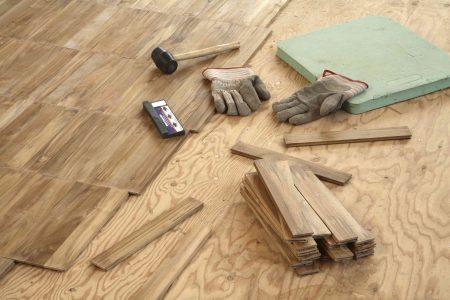For all their durability and ease of maintenance, concrete steps can become worn after a while. The corners and edges of stair noses can chip away through ordinary use. The abuse can be even more pronounced when heavy items like boxes and hand trucks are hauled up and down the steps.
Repairing your concrete steps is simply a natural component of the steps’ lifecycle. You can repair cracked or chipped concrete steps quickly and easily with a few basic materials and tools found at your local home center.
Concrete Step Repair Basics
Concrete steps whose tread noses or corners are chipped can be repaired by first cleaning the area, then sculpting a replacement section with concrete and a margin trowel.
For small repairs, no form is necessary. The trick to a successful repair without using a form is two-fold: preparation and rapid sculpting.
First, the concrete area to be repaired must be flawlessly cleaned of all debris, dirt, dust, and moss, as any of those can cause the repair section to fail.
Second, since concrete sets quickly, you will need to work relatively quickly. Concrete becomes hard to the touch in about 10 minutes. Plan the contours of your intended patch before you mix up the concrete.
Why You Should Repair Your Concrete Steps
Besides the risk of injury to yourself or your family, you are legally liable for injuries that occur on your property. Keep yourself, visitors, and delivery people safe by repairing your concrete steps.
From a physical standpoint, once the concrete has been allowed to deteriorate in a minor way—through spalling (flaking or peeling), small breaks or chips, de-lamination, cracking, or blistering—further deterioration occurs exponentially. Catching the problem early on is critical to preventing rebuilding the steps entirely.
Codes, Regulations, and Permits
Your community may not require you to apply for a building permit for minor concrete step repairs. Whether or not you are required to have a building permit for the project, you should always adhere to the building code pertaining to steps.
When to Repair Concrete Steps
In the interests of safety, hazardous concrete steps should be repaired immediately. Be mindful of the temperature ranges of the concrete repair product you will be using. Concrete applied below 45 degrees Fahrenheit or above 90 degrees Fahrenheit often may not cure or will cure exceedingly slowly.
Safety Considerations
Avoid breathing concrete products’ dust since exposure may irritate eyes, nose, and lungs. Wear a mask, gloves, and safety glasses.
What You’ll Need
Equipment / Tools
- Wire brush
- Margin trowel
- Hammer
- Masonry chisel
- Shop vacuum
- 5-gallon bucket
- Spray bottle and water
Materials
- Quick-setting concrete
- Acrylic fortifier
- Liquid concrete and asphalt cleaner
Instructions
-
Clean and Prepare the Concrete
- With a broom, sweep the surface free of all debris.
- Use a wire brush to scour the concrete.
- Chip away hanging pieces of concrete with the hammer and chisel.
- Remove mold or mildew with bleach.
- Use a zinc-based moss-killer or even kitchen detergent to kill moss on the steps.
- Use a hose and a brush or a pressure washer to further clean the surface.
- Remove oil stains, paint, or tree sap with a concrete cleaner.
Warning
Be careful when pressure washing your concrete stairs as the impact of water can further damage your steps.
-
Mix the Concrete
Mix up the concrete in the 5-gallon bucket with the recommended amount of water. Add the concrete fortifier at a ratio of 4:1. Mix to the consistency of peanut butter.
-
Wet the Surface
Lightly spray the surface to be repaired with water.
-
Fill the Broken Area
Build up the broken section in layers. First, press concrete into the broken section with the margin trowel. At this point, you are only aiming to add mass, not form, to that section.
-
Sculpt the Concrete Fill
While the mass fill is still wet, bring more concrete over with the margin trowel and pat it into place. Initially, you will need slightly more concrete than is required for that section. Sculpt the corner or the edge with the trowel. Place excess concrete back in the bucket. Smooth out the concrete fill so that it is flush with the rest of the step.
-
Let the Concrete Cure
Spray down the concrete patch with the spray bottle and keep it lightly wet for 24 hours. Do not permit traffic on the steps until the patch is fully cured.
When to Call a Professional
A mason or general contractor can repair your concrete steps. You may want to contact either professional for your project, if the damage to the concrete steps is extensive or if it extends deep within the structure of the steps.
Read the full article here














